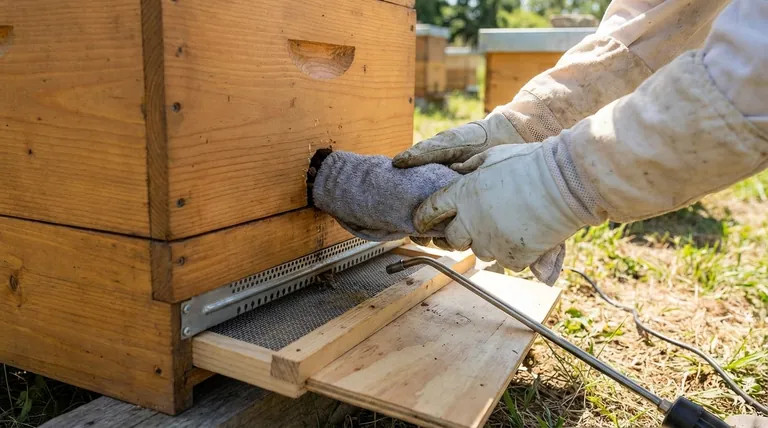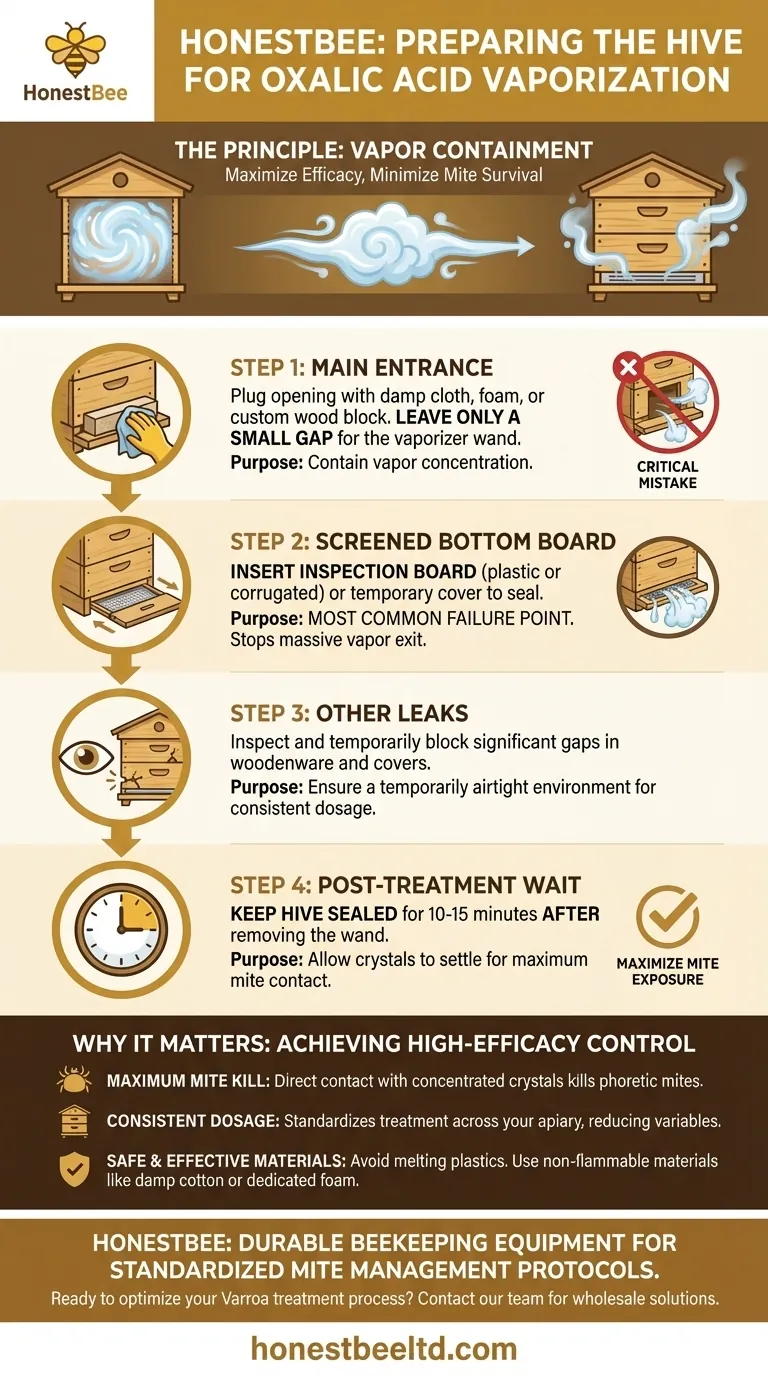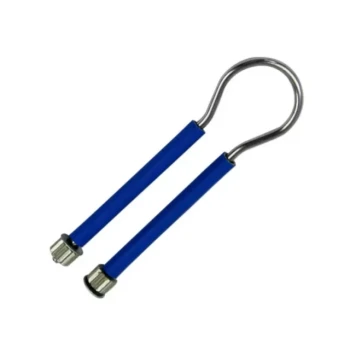To properly use an oxalic acid vaporizer, you must first prepare the hive by sealing the main entrance. This is typically done by plugging the opening with a damp cloth, a strip of foam, or a custom-cut wood block, leaving just enough space to insert the vaporizer's wand.
The core principle is vapor containment. Sealing the hive entrance and any other significant gaps ensures the oxalic acid vapor remains concentrated within the hive long enough to effectively kill phoretic Varroa mites.

The Principle of Vapor Containment
Successful vaporization hinges on creating a temporary, saturated environment inside the hive. Simply inserting the wand into an open hive is a common and critical mistake.
Why Sealing is Critical
The goal is to ensure the fine crystals of sublimated oxalic acid coat the bees and hive surfaces. If the entrance is open, a significant portion of the vapor will immediately escape.
This rapid escape drastically reduces the concentration of the acid, rendering the treatment less effective and wasting both time and material.
Maximizing Mite Exposure
Varroa mites are the target, and they are killed upon direct contact with the oxalic acid crystals.
By sealing the hive, you ensure the vapor remains suspended and circulating, increasing the probability that every phoretic mite (mites on the bodies of adult bees) is exposed to a lethal dose.
Ensuring a Consistent Dosage
An unsealed hive introduces a major variable. Wind, entrance size, and hive drafts can all affect how much vapor is lost.
Sealing the hive standardizes the treatment. It helps guarantee that each colony receives a similar, effective concentration of oxalic acid, leading to more reliable and predictable results across your apiary.
Practical Steps for Sealing the Hive
Properly sealing the hive is a quick but essential step. Pay attention not only to the main entrance but to all potential escape routes.
Preparing the Main Entrance
The most common method is to use a damp cloth, old towel, or a block of dense foam to plug the main entrance.
Make sure the material creates a tight seal across the entire opening. You only need to leave a small gap that is just large enough to slide the hot nozzle of the vaporizer through.
Addressing Screened Bottom Boards
A screened bottom board is a massive exit point for vapor. This is the most common point of failure in a vaporization treatment.
Before you begin, slide the inspection board (often a plastic or corrugated plastic sheet) into place to seal the bottom. If you don't have one, use a piece of cardboard or wood cut to size and placed under the screen.
Checking for Other Leaks
Briefly inspect the hive for other significant gaps. Check for cracks in old woodenware or gaps around the inner cover or telescoping top cover. While minor cracks are not a major concern, large openings should be temporarily blocked.
Understanding the Trade-offs and Risks
While simple, the sealing process has implications for both safety and effectiveness.
The Consequence of Incomplete Sealing
The primary risk is not to the bees, but to the treatment's success. An incomplete seal directly translates to a lower mite kill rate.
This can give you a false sense of security, allowing the Varroa population to rebound quickly, potentially leading to colony losses later in the season.
Material Choice Matters
Do not use materials that can melt, burn, or release toxic fumes when exposed to the high heat of the vaporizer wand.
Avoid styrofoam or low-density plastics near the wand's nozzle. A damp cotton towel is effective because it's non-flammable and the moisture helps create an even better seal. Purpose-made foam blocks for beekeepers are also an excellent choice.
Post-Treatment Sealing
The job isn't done the moment the vaporizer is turned off. The hive should remain sealed for an additional 10 to 15 minutes after the wand is removed.
This crucial waiting period allows the suspended acid crystals to settle onto the bees and surfaces within the hive, maximizing the treatment's impact.
Making the Right Choice for Your Goal
Your goal is a high-efficacy Varroa treatment. The preparation you do directly impacts the result.
- If your primary focus is maximum efficacy: Always seal the main entrance, any large gaps, and especially the screened bottom board before every treatment.
- If your primary focus is efficiency and safety: Use a pre-cut, reusable foam block or a dedicated wooden entrance reducer designed for vaporization to ensure a fast, consistent, and safe seal.
- If your primary focus is consistency across your apiary: Develop a standard operating procedure for sealing every hive the same way and leaving it sealed for the full recommended time post-treatment.
Properly preparing the hive is the foundation for a successful oxalic acid vaporization.
Summary Table:
| Preparation Step | Key Action | Purpose |
|---|---|---|
| Main Entrance | Plug with damp cloth, foam, or wood block. | Contain vapor, leaving only a small gap for the wand. |
| Screened Bottom | Insert the inspection board or a temporary cover. | Seal the largest potential vapor escape route. |
| Other Leaks | Check for and block significant gaps in the hive body. | Ensure a temporarily airtight environment. |
| Post-Treatment | Keep the hive sealed for 10-15 minutes after treatment. | Allow acid crystals to settle for maximum efficacy. |
Achieve Consistent, High-Efficacy Varroa Control with the Right Equipment
Proper preparation is the foundation of a successful treatment. For commercial apiaries and distributors, having reliable, purpose-built supplies is key to operational efficiency and colony health.
HONESTBEE supplies the durable beekeeping equipment and supplies you need—from vaporizers to sealing materials—to standardize your mite management protocol across your entire operation.
Ready to optimize your Varroa treatment process? Contact our team today to discuss wholesale solutions tailored for commercial beekeepers.
Visual Guide

Related Products
- HONESTBEE Professional Long Handled Hive Tool with Precision Cutting Blade
- Multi-Function Plier-Style Frame Grip Hive Tool
- Professional Dual-End Stainless Steel Hive Tool for Beekeeping
- HONESTBEE Professional Multi-Functional Hive Tool with Ergonomic Wood Handle
- Professional Multi-Function Stainless Steel Hive Tool
People Also Ask
- Why do hive tools have a hole? Unlock the Secret to Efficient Beekeeping
- What tools are used for cleaning frames? A Beekeeper's Simple 4-Tool Guide
- What are some common uses of a hive tool? Essential Multi-Purpose Tool for Every Beekeeper
- How should beekeepers handle bees when using a hive tool? Master Calm, Deliberate Techniques
- What is a hive tool used for in beekeeping? Your Essential Guide to Hive Management



















